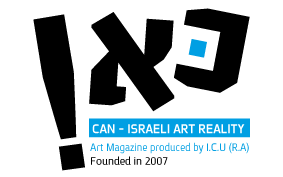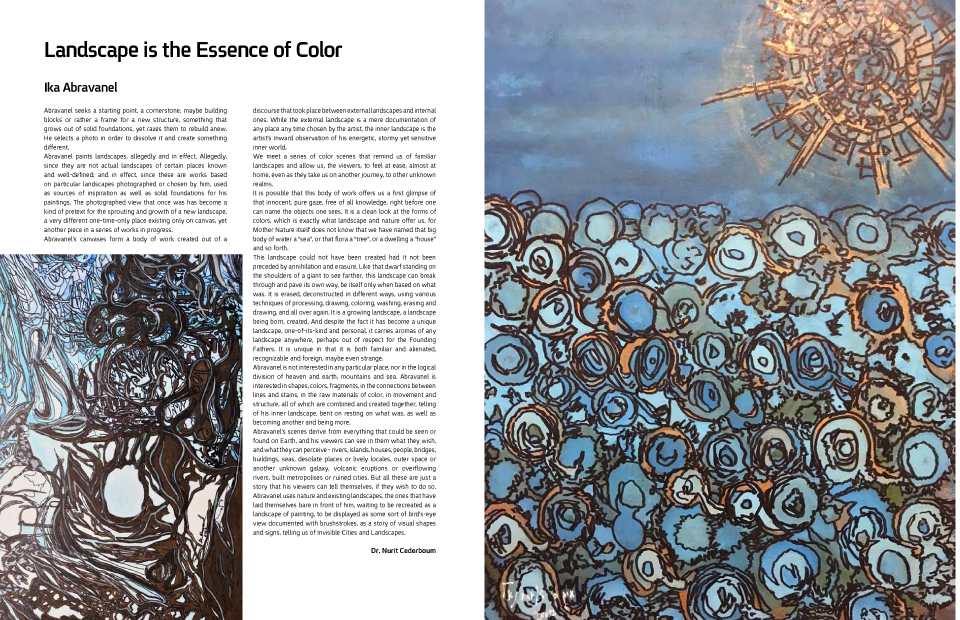
| Home Page | Editor Notices | Museums | Galleries | Publication | Donation | Contact Us |


 | |||||||||||||||
| |||||||||||||||


| |||||||||||||||
| Landscape is the Essence of Color / Ika Abravanel |
Abravanel seeks a starting point, a cornerstone, maybe building blocks or rather a frame for a new structure, something that grows out of solid foundations, yet razes them to rebuild anew. He selects a photo in order to dissolve it and create something different. Abravanel paints landscapes, allegedly and in effect. Allegedly, since they are not actual landscapes of certain places known and well-defined; and in effect, since these are works based on particular landscapes photographed or chosen by him, used as sources of inspiration as well as solid foundations for his paintings. The photographed view that once was has become a kind of pretext for the sprouting and growth of a new landscape, a very different one-time-only place existing only on canvas, yet another piece in a series of works in progress. Abravanel's canvases form a body of work created out of a discourse that took place between external landscapes and internal ones. While the external landscape is a mere documentation of any place any time chosen by the artist, the inner landscape is the artist's inward observation of his energetic, stormy yet sensitive inner world. We meet a series of color scenes that remind us of familiar landscapes and allow us, the viewers, to feel at ease, almost at home, even as they take us on another journey, to other unknown realms. It is possible that this body of work offers us a first glimpse of that innocent, pure gaze, free of all knowledge, right before one can name the objects one sees. It is a clean look at the forms of colors, which is exactly what landscape and nature offer us, for Mother Nature itself does not know that we have named that big body of water a “sea”, or that flora a “tree”, or a dwelling a “house” and so forth. This landscape could not have been created had it not been preceded by annihilation and erasure. Like that dwarf standing on the shoulders of a giant to see farther, this landscape can break through and pave its own way, be itself only when based on what was. It is erased, deconstructed in different ways, using various techniques of processing, drawing, coloring, washing, erasing and drawing, and all over again. It is a growing landscape, a landscape being born, created. And despite the fact it has become a unique landscape, one-of-its-kind and personal, it carries aromas of any landscape anywhere, perhaps out of respect for the Founding Fathers. It is unique in that it is both familiar and alienated, recognizable and foreign, maybe even strange. Abravanel is not interested in any particular place, nor in the logical division of heaven and earth, mountains and sea. Abravanel is interested in shapes, colors, fragments, in the connections between lines and stains, in the raw materials of color, in movement and structure, all of which are combined and created together, telling of his inner landscape, bent on resting on what was, as well as becoming another and being more. Abravanel’s scenes derive from everything that could be seen or found on Earth, and his viewers can see in them what they wish, and what they can perceive - rivers, islands, houses, people, bridges, buildings, seas, desolate places or lively locales, outer space or another unknown galaxy, volcanic eruptions or overflowing rivers, built metropolises or ruined cities. But all these are just a story that his viewers can tell themselves, if they wish to do so. Abravanel uses nature and existing landscapes, the ones that have laid themselves bare in front of him, waiting to be recreated as a landscape of painting, to be displayed as some sort of bird's-eye view documented with brushstrokes, as a story of visual shapes and signs, telling us of Invisible Cities and Landscapes. Dr. Nurit Cederboum Read more  |
| all rights reserved - CAN ISRAELI ART REALITY |
| סייבורג מחשבים - בניית אתרים |